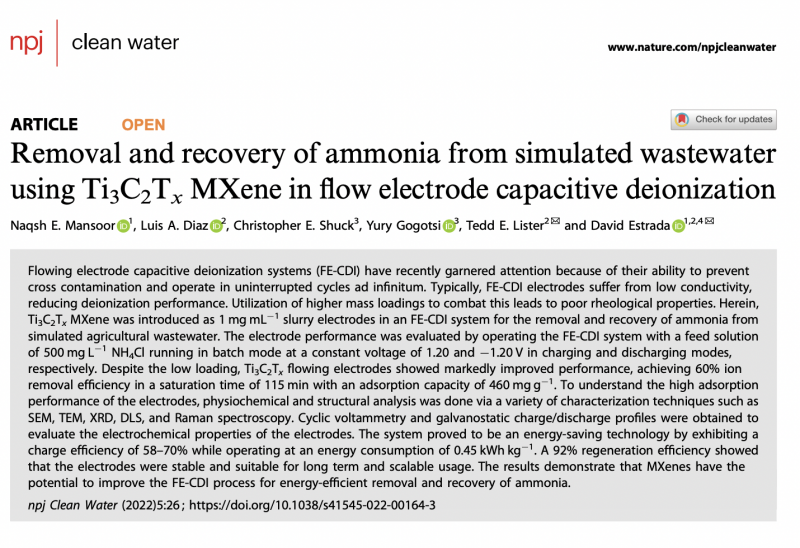Efficient Technique Removes Ammonia From Agricultural Wastewater
Published on by Water Network Research, Official research team of The Water Network in Academic
Boise State researchers from the College of Engineering joined with researchers from Drexel University and the Idaho National Laboratory to investigate a simple, energy efficient technique to remove ammonia from agricultural wastewater. Research is co-led by Estrada and Tedd Lister, a chemical separations researcher in Idaho National Laboratory’s Energy and Environment Science and Technology directorate. The group’s work was published in the Nature Partner Journal, Clean Water.
The research team utilized capacitive deionization, an emerging water treatment technique in which water flows between two oppositely charged electrodes. This technique polarizes ionic impurities in wastewater, causing the ions to be attracted and stored in the opposing electrodes.
“It takes approximately 20 times the amount of energy to synthesize ammonia from fossil fuels as it does to recover ammonia using our approach,” Lister said. “Such fossil fuel based industrial processes can generate up to four times the amount of carbon dioxide as the amount of ammonia that is synthesized, highlighting the importance of recycling our resources made using such energy intensive techniques.”
The team examined previous studies which explored carbon-based materials as electrodes, however, these materials were limited in chemical diversity, surface chemistries, and surface-area-to-volume ratio, which limit the performance of the capacitive deionization technique. The team partnered with Chris Schuck and Yury Gogotsi at Drexel University to investigate a new approach utilizing MXenes, an inorganic compound composed of layers of nitrides, carbonitrides, or metal carbides.
“MXenes have a unique combination of properties that make them very attractive for electrochemical applications,” said Naqsh Mansoor, a Boise State graduate student in the Micron School of Materials Science and Engineering and first author on the paper. “The fanned-out structure of MXenes allows plenty of intercalation space so that removed pollutant ions can not only absorb on the surface but also insert themselves between the layers.”
The team’s research found a 100 times improvement in the deionization capacity when using MXenes in comparison to activated carbon-based electrode systems. This resulted in a higher number of pollutant ions pulled from the wastewater stream while using less of the electrode material.
Reference: Mansoor NE, Diaz LA, Shuck CE, Gogotsi Y, Lister TE, Estrada D. Removal and recovery of ammonia from simulated wastewater using Ti3C2Tx MXene in flow electrode capacitive deionization. npj Clean Water. 2022;5(1):1-11. doi: 10.1038/s41545-022-00164-3
This article has been republished from the following materials. Note: material may have been edited for length and content. For further information, please contact the cited source.
SEE FULL PAPER ATTACHED
